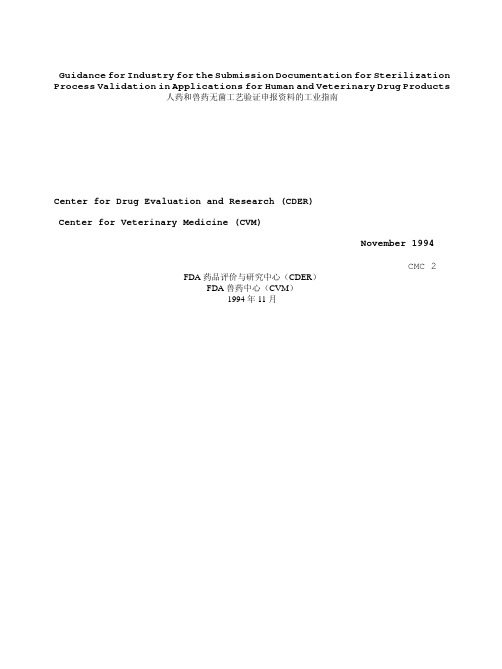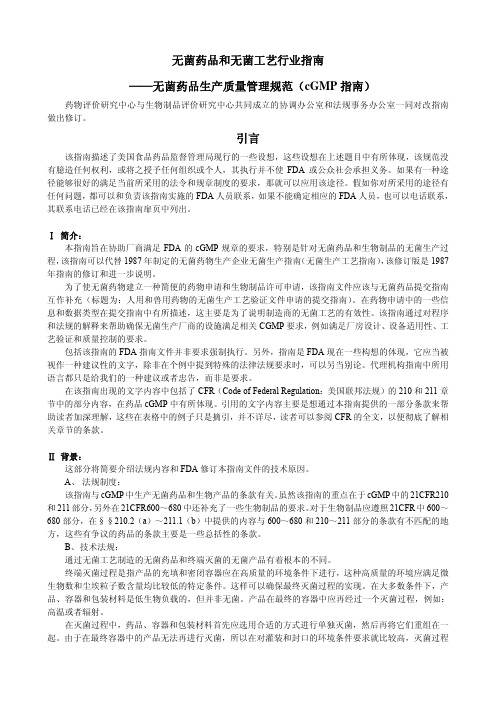PI 007-6 无菌工艺验证的建议(中英文对照)
- 格式:pdf
- 大小:680.21 KB
- 文档页数:39
![EUGMP-中英文对照[1]](https://img.taocdn.com/s1/m/ed974fef59eef8c75ebfb3e2.png)
EU GMP ANNEX 1 MANUFACTURE OF STERILE MEDICINAL PRODUCTS (中英文对照)(a) These are average values. (一)这些都是平均值。
(b) Individual settle plates may be exposed for less than 4 hours. (二)单个沉降皿放置的时间可以少于4小时。
20. Appropriate alert and action limits should be set for the results of particulate and microbiological monitoring. If these limits are exceeded operating procedures should prescribe corrective action。
对尘埃粒子和微生物的监控结果,要设置适当的警戒限度和行动限度。
当超出这些限度时,操作规程应说明需要采取的措施。
Isolator technology 隔离技术21. The utilisation of isolator technology to minimize human interventions in processing areas may result in a significant decrease in the risk of microbiological contamination of aseptically manufactured products from the environment. There are many possible designs of isolators and transfer devices. The isolator and the background environment should be designed so that the required air quality for the respective zones can be realised. Isolators are constructed of various materials more or less prone to puncture and leakage. Transfer devices may vary from a single door to double door designs to fully sealed systems incorporating sterilization mechanisms. 在生产区采用人员方面的隔离技术,在无菌产品的生产中,会显著降低周围环境微生物污染的风险。

Guidance for Industry for the Submission Documentation for Sterilization Process Validation in Applications for Human and Veterinary Drug Products人药和兽药无菌工艺验证申报资料的工业指南Center for Drug Evaluation and Research (CDER)Center for Veterinary Medicine (CVM)November 1994CMC 2FDA药品评价与研究中心(CDER)FDA兽药中心(CVM)1994年11月TABLE OF CONTENTSI. INTRODUCTION (1)A. Purpose (1)B. Documenting Sterilization Process Validation (2)C. Remarks (2)II. INFORMATION FOR TERMINAL MOIST HEAT STERILIZATIONPROCESSES (3)A. Description of the Process and Product ........................ .. (3)1. The Drug Product and Container-Closure System (3)2. The Sterilization Process (3)3. The Autoclave Process and Performance Specifications (4)4. Autoclave Loading Patterns (4)5. Methods and Controls to Monitor Production Cycles (4)6. Requalification of Production Autoclaves (4)7. Reprocessing (4)B. Thermal Qualification of the Cycle (4)1. Heat Distribution and Penetration Studies (4)2. Thermal Monitors (5)3. The Effects of Loading on Thermal Input (5)4. Information Included in the Batch Record ........................................... . 5C. Microbiological Efficacy of the Cycle (5)1. Identification and Characterization of Bioburden Organisms (6)2. Specifications for Bioburden (6)3. Identification, Resistance, and Stability of BiologicalIndicators (6)4. The Resistance of the Biological Indicator Relative to That ofBioburden (6)5. Microbiological Challenge Studies (7)D. Microbiological Monitoring of the Environment (7)E. Container-Closure and Package Integrity (7)1. Simulation of the Stresses From Processing (7)2. Demonstrate Integrity Following the Maximum Exposure (8)3. Multiple Barriers (8)4. The Sensitivity of the Test (8)5. Integrity Over the Product Shelf Life (8)F. Bacterial Endotoxins Test and Method (8)G. Sterility Testing Methods and Release Criteria (8)H. Evidence of Formal, Written Procedures (9)III. OTHER TERMINAL STERILIZATION PROCESSES (9)A. Ethylene Oxide (9)1. Description of the Sterilizer (9)2. Cycle Parameters (10)3. Microbiological Methods (10)4. Stability (10)B. Radiation (10)1. The Facility and the Process (10)2. The Packaging of the Product (10)3. Multiple-Dose Mapping Studies (10)4. Microbiological Methods and Controls (11)5. Monitoring Stability (11)IV. INFORMATION FOR ASEPTIC FILL MANUFACTURING PROCESSES WHICH SHOULD BE INCLUDED IN DRUG APPLICATIONS (11)A. Buildings and Facilities (11)1. Floor Plan (11)2. Location of equipment (11)B. Overall Manufacturing Operation (11)1. Drug Product Solution Filtration (12)2. Specifications Concerning Holding Periods (12)3. Critical Operations (12)C. Sterilization and Depyrogenation of Containers, Closures, Equipment, andComponents (12)1. Bulk Drug Solution Components That are SterilizedSeparately (13)2. Sterilization Information in the Batch Records (13)D. Procedures and Specifications for Media Fills (13)E. Actions Concerning Product When Media Fills Fail (14)F. Microbiological monitoring of the environment (15)1. Microbiological Methods (15)2. Yeasts, Molds, and Anaerobic Microorganisms (15)3. Exceeded Limits (15)G. Container-Closure and Package Integrity (15)H. Sterility Testing Methods and Release Criteria (16)I. Bacterial Endotoxins Test and Method (16)J. Evidence of Formal Written Procedures (16)V. MAINTENANCE OF MICROBIOLOGICAL CONTROL AND QUALITY: STABILITY CONSIDERATIONS (16)A. Container-Closure Integrity (16)B. Preservative Effectiveness (17)C. Pyrogen or Endotoxin Testing (17)VI. ADDITIONAL INFORMATION (17)GUIDANCE FOR INDUSTRY1FOR THE SUBMISSION OF DOCUMENTATION FOR STERILIZATION PROCESS VALIDATION IN APPLICATIONS FOR HUMAN AND VETERINARY DRUGPRODUCTS人药和兽药无菌工艺验证申报资料的工业指南I. INTRODUCTION1、概述A. PurposeThis document is intended to provide guidance for the submission of information and data in support of the efficacy of sterilization processes in drug applications for both human and veterinary drugs. The recommendations in the guidance apply to applications for sterile drug products (new drug applications, new animal drug applications, abbreviated new drug applications, abbreviated antibiotic applications, and abbreviated new animal drug applications). These recommendations also apply to previously approved applications when supplements associated with the sterile processing of approved drugs are submitted. Information and data in support of sterility assurance may also be necessary in investigational new drug and investigational new animal drug applications.A. 目的本文件旨在为证明人药和兽药无菌工艺有效性申请上报的信息和资料提供指南。

2. INTRODUCTIONThe basic principles and application of qualification and validation are describedin Annex 15 to the PIC/S and EU Guide to GMP.This document comprises individual Recommendations on four topics relatingto Equipment Qualification and Process Validation in pharmaceuticalmanufacture, as follows:Ø Validation Master PlanØ Installation and Operational QualificationØ Non-Sterile Process ValidationØ Cleaning ValidationThe four Recommendations comprising this document define general principles pertaining to each of the topics.2. 导言PIC/S和EU GMP指导原则的附录15中对确认(Qualification)和验证(Validation)的基本原则及应用进行了阐述。
本文件包含了药物生产过中与设备确认和工艺验证相关的如下这四个方面的建议:验证主计划安装和运行确认非无菌工艺验证清洗验证本文件中的建议确定了上述这四个方面的基本原则。
2.1 Purpose of the document2.1.1 The topics of these Recommendation documents reflect some of the areas in pharmaceutical manufacture identified by both Inspectorates and thePharmaceutical Industry as requiring guidance additional to that given in thecurrent PIC/S GMP Guide.2.1.2 The purpose of this document is to provide guidance for GMP inspectors in reviewing the issues covered to use for training purposes and in preparation for inspections.2.1 本文件的目的2.1.1 这些建议性文件的主题涉及的是那些审计人员和制药企业都认为需要对现行PIC/S GMP指导原则进行补充的领域。



无菌药品和无菌工艺行业指南——无菌药品生产质量管理规范(cGMP指南)药物评价研究中心与生物制品评价研究中心共同成立的协调办公室和法规事务办公室一同对改指南做出修订。
引言该指南描述了美国食品药品监督管理局现行的一些设想,这些设想在上述题目中有所体现,该规范没有臆造任何权利,或将之授予任何组织或个人,其执行并不使FDA或公众社会承担义务。
如果有一种途径能够很好的满足当前所采用的法令和规章制度的要求,那就可以应用该途径。
假如你对所采用的途径有任何问题,都可以和负责该指南实施的FDA人员联系,如果不能确定相应的FDA人员,也可以电话联系,其联系电话已经在该指南扉页中列出。
Ⅰ简介:本指南旨在协助厂商满足FDA的cGMP规章的要求,特别是针对无菌药品和生物制品的无菌生产过程,该指南可以代替1987年制定的无菌药物生产企业无菌生产指南(无菌生产工艺指南),该修订版是1987年指南的修订和进一步说明。
为了使无菌药物建立一种简便的药物申请和生物制品许可申请,该指南文件应该与无菌药品提交指南互作补充(标题为:人用和兽用药物的无菌生产工艺验证文件申请的提交指南)。
在药物申请中的一些信息和数据类型在提交指南中有所描述,这主要是为了说明制造商的无菌工艺的有效性。
该指南通过对程序和法规的解释来帮助确保无菌生产厂商的设施满足相关CGMP要求,例如满足厂房设计、设备适用性、工艺验证和质量控制的要求。
包括该指南的FDA指南文件并非要求强制执行。
另外,指南是FDA现在一些构想的体现,它应当被视作一种建议性的文字,除非在个例中提到特殊的法律法规要求时,可以另当别论。
代理机构指南中所用语言都只是给我们的一种建议或者忠告,而非是要求。
在该指南出现的文字内容中包括了CFR(Code of Federal Regulation:美国联邦法规)的210和211章节中的部分内容,在药品cGMP中有所体现。
引用的文字内容主要是想通过本指南提供的一部分条款来帮助读者加深理解,这些在表格中的例子只是摘引,并不详尽,读者可以参阅CFR的全文,以便彻底了解相关章节的条款。
GUIDE TO INSPECTIONS OF STERILE DRUG SUBSTANCE MANUFACTURERSFDA无菌原料药检查指南Note: This document is reference material for investigators and other FDA personnel. The document does not bind FDA, and does no confer any rights, privileges, benefits, or immunities for or on any person(s).注:本文件是FDA现场检查官和其他FDA人员的参考资料。
本文件并不束缚FDA,也不赋予任何人任何权利、特权、好处以便获得赦免。
One of the more difficult processes to inspect and one which has presented considerable problems over the years is that of the manufacture of sterile bulk drug substances. Within the past several years, there have been a number of batches of sterile bulk drug substances from different manufacturers which exhibited microbiological contamination. One manufacturer had approximately 100 batches contaminated in a 6 month time period. Another had approximately 25 batches contaminated in a similar period. Other manufacturers have had recalls due to the lack of assurance of sterility. Although the Inspection Guide for Bulk Drug Substances provides some direction for the inspection of the sterile bulk drug substance, it does not provide the detailed direction needed.在过去多年中,现场检查最难的,也是出现问题最多的领域就是无菌原料药的制造。
灭菌/无菌工艺验证指导原则(第二稿)目录1概述 (1)2制剂湿热灭菌工艺 (3)2.1湿热灭菌工艺的研究 (3)2.1.1 湿热灭菌工艺的确定依据 (3)2.1.2过度杀灭法的工艺研究 (4)2.1.3残存概率法的工艺研究 (5)2.2湿热灭菌工艺的验证 (6)2.2.1物理确认 (6)2.2.2 生物学确认 (8)3制剂无菌生产工艺 (10)3.1无菌生产工艺的研究 (10)3.1.1无菌分装生产工艺的研究 (10)3.1.2 过滤除菌生产工艺的研究 (11)3.2 无菌生产工艺的验证 (11)3.2.1培养基模拟灌装试验 (12)3.2.2 除菌过滤系统的验证 (14)4原料药无菌生产工艺 (16)4.1 无菌原料药生产工艺特点 (17)4.1.1 溶媒结晶工艺 (18)4.1.2 冷冻干燥工艺 (18)4.2 无菌原料药工艺验证 (18)4.2.1 验证批量 (19)4.2.2 最差条件 (19)1概述无菌药品是指法定药品标准中列有无菌检查项目的制剂和原料药,一般包括注射剂、无菌原料药及滴眼剂等。
从严格意义上讲,无菌药品应完全不含有任何活的微生物,但由于目前检验手段的局限性,绝对无菌的概念不能适用于对整批产品的无菌性评价,因此目前所使用的“无菌”概念,是概率意义上的“无菌”。
一批药品的无菌特性只能通过该批药品中活微生物存在的概率低至某个可接受的水平,即无菌保证水平(Sterility Assurance Level, SAL)来表征。
而这种概率意义上的无菌保证取决于合理且经过验证的灭菌工艺过程、良好的无菌保证体系以及生产过程中严格的GMP管理。
无菌药品通常的灭菌方式可分为:1)湿热灭菌;2)干热灭菌;3)辐射灭菌;4)气体灭菌;5)除菌过滤。
按工艺的不同分为最终灭菌工艺(sterilizing process)和无菌生产工艺(aseptic processing)。
其中最终灭菌工艺系指将完成最终密封的产品进行适当灭菌的工艺,由此生产的无菌制剂称为最终灭菌无菌药品,湿热灭菌和辐射灭菌均属于此范畴。